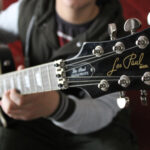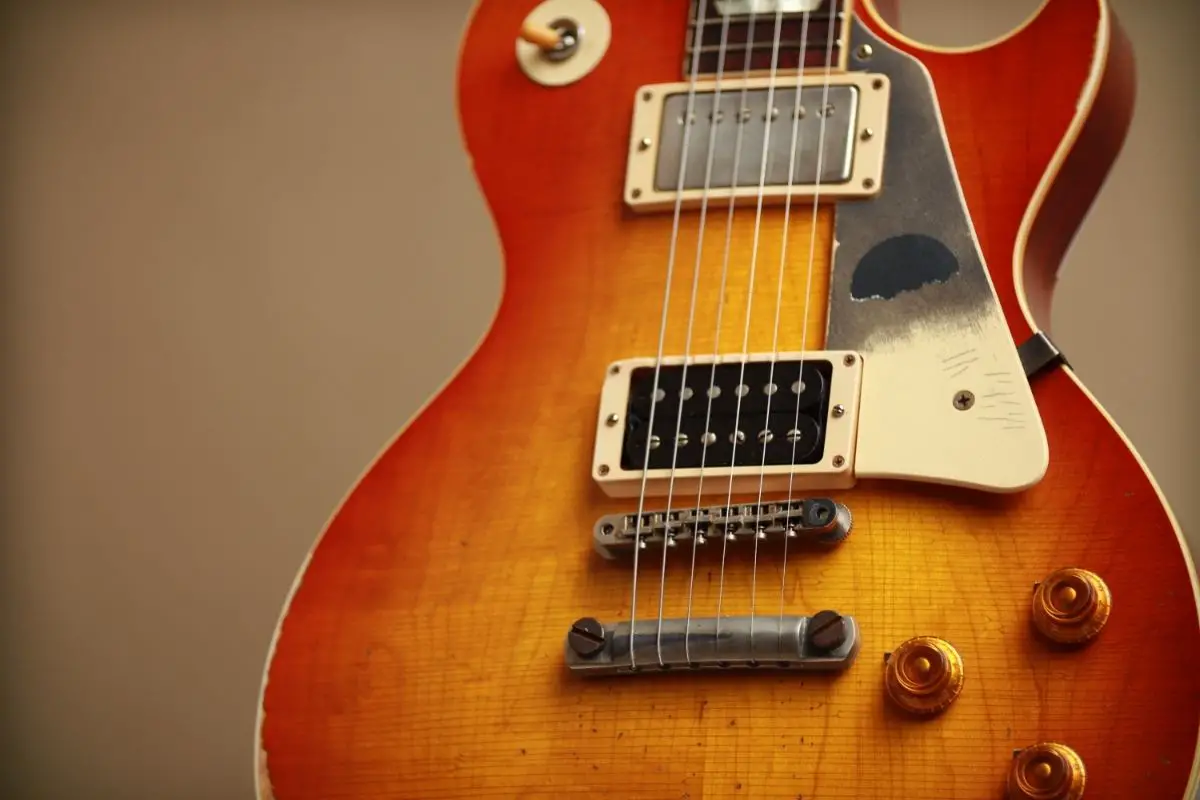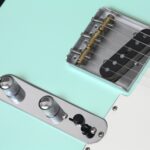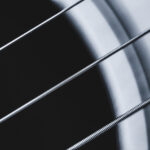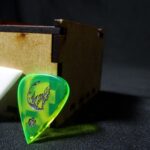Eddie Van Halen was known for his groundbreaking guitar techniques and innovative sound, influencing countless musicians and aspiring guitarists worldwide.
One key aspect of Eddie’s signature tone is the guitar pickups he used throughout his career. While he experimented with various brands and models, there are a few that stand out as integral components of his legendary sound.

In the early years of Van Halen, particularly during the recording of their 1978 debut album, Eddie used a Gibson PAF humbucker that was rewound to be even hotter, similar to the SH-5 Custom.
As his career progressed, he would use other pickups from different brands, such as DiMarzio. Some notable DiMarzio pickups associated with Eddie’s tone include the Air Norton™ for the neck position and The Tone Zone® or DiMarzio® AT-1™ for the bridge position of his guitars.
Key Takeaways on What Pickups Did Eddie Van Halen Use?
- Eddie Van Halen used various guitar pickups to achieve his signature tone, starting with a hot-modified Gibson PAF humbucker.
- In later years, Eddie became associated with DiMarzio pickups like the Air Norton™, The Tone Zone®, and DiMarzio® AT-1™.
- Eddie’s choice of pickups contributed to the distinctive sound of his guitars, playing a significant role in his legacy and influence on guitarists worldwide.
Also don’t miss:
- What Pickups Did Jimi Hendrix Use?
- What Gauge Strings Did Eddie Van Halen Use?
- What Strings Did Eddie Van Halen Use?
Establishing Eddie Van Halen’s Signature Tone
Eddie Van Halen, often referred to as EVH, revolutionized the world of guitar playing with his unique and powerful tone. Known as the “Brown Sound,” his signature tone was a combination of various elements including pickups, amplifiers, and effects.
At the heart of Eddie’s sound were his choice of pickups. During the years 1978-1984, it is believed that Eddie used an SH-5 Custom or a rewound PAF with a ceramic magnet in his iconic Frankenstrat guitar. These high-output pickups provided the strong midrange and powerful low end required for his aggressive playing style.
In addition to the right pickups, Eddie’s tone relied heavily on his choice of amplifier. The Marshall Super Lead was a key component in achieving his sound. This classic amplifier is known for its rich, warm distortion and high gain that contributed to the characteristic overdrive in his playing.
Further enhancing his tone, Eddie employed a technique known as the Variac. By using a variable auto-transformer, he was able to manipulate the voltage supplied to his amplifiers, allowing him to achieve a distinct combination of overdrive and distortion.
Eddie also utilized various effects to achieve his legendary tone. The Echoplex EP-3 tape echo provided extra depth and sustain, shaping the overall sound of his guitar.
While some aspects of Eddie Van Halen’s tone are well-documented, it still remains somewhat elusive due to the many nuances involved. It is clear, however, that the combination of specific pickups, the Marshall Super Lead, a Variac, and the judicious use of effects all played a role in creating his legendary sound.
The Famous Guitars and Their Pickups
Eddie Van Halen was known for his innovative and unique style on the guitar, often experimenting with different guitars and their pickups, ultimately producing iconic tones.
One of the most famous guitars he created is the Frankenstrat, a hybrid of a Fender Stratocaster and a Gibson Les Paul. The Frankenstrat featured a humbucker pickup pulled from Eddie’s Gibson ES-335, providing a powerful and distinctive sound.
Another significant guitar in Eddie’s collection is the Ibanez Destroyer, which he modified by removing a chunk of wood from the body. He also swapped out the stock pickups for a Seymour Duncan Super Distortion humbucker and a Mighty Mite single-coil, creating a unique combination of tones.
Eddie’s pursuit of his signature sound involved a variety of guitars and pickups over the years. For instance, he collaborated with Wayne Charvel to create the Star guitar, fitted with a single humbucker.
Further collaborations led to the development of the Ernie Ball Music Man EVH, the Peavey 5150, and the EVH Wolfgang, each designed with specific pickups to enhance Eddie’s unparalleled sonic qualities.
His famous 5150 Guitar, a Kramer-built model, was yet another milestone in his career. This instrument featured a single humbucker pickup and a Strat-style body for a perfect blend of Eddie’s preferences.
Over the years, Eddie created several unique guitars with eye-catching designs, such as the Bumblebee, Circles, Rasta, and Stealth Black, all featuring his preferred humbucker pickups and signature styling.
Although Eddie primarily used humbucker pickups for their powerful output and distinctive sound, he occasionally experimented with single-coil pickups, giving each guitar its own unique character.
In various interviews, Eddie expressed his fondness towards Gibson Les Pauls, Fender Stratocasters, and Gibson ES-335s, showcasing his diverse taste in guitars and the impact these models had on his sound throughout his career.
Eddie’s Distinctive Effects and Pedals
Eddie Van Halen was well-known for creating a signature sound with the help of various effects and pedals. One key component of his distinct tone was his use of MXR Phaser, Flanger, and Chorus effects. These effects, when combined, made his guitar sound fuller, more aggressive, and unique.
His pedalboard setup also included a Floyd Rose tremolo system for increased pitch range when using the vibrato bar. In terms of pickups, Eddie often opted for DiMarzio pickups to further define his sound.
The MXR Phase 90, in particular, was heavily used by Eddie on many Van Halen tracks. This phase shifter effect had a major impact on his tone and style. Today, an EVH Signature model of the MXR Phase 90 is even available, showing the ongoing legacy of this popular pedal.
An item known as a Variac was another essential part of Eddie’s rig. This adjustable voltage transformer allowed him to manipulate the voltage going into his amplifier, helping him achieve his signature “brown sound” – a warm, saturated overdrive. This approach of using the Variac in conjunction with his amp set the stage for many guitarists who sought similar tones.
In an attempt to create a glitchy sound, Eddie also incorporated a “kill switch” into his guitars, enabling him to quickly mute the guitar output while simultaneously playing fast passages.
Additionally, Roland SDE-3000 digital delay units were used to provide him with precise control over the timing and repetition of his delays.
Eddie Van Halen’s unique sound came as a result of his innovative approach to using various effects, pedals, and gear like the MXR Phaser, Flanger, Chorus effects, Floyd Rose tremolo system, DiMarzio pickups, Variac, and Roland SDE-3000 digital delay units. His influence on guitar tones and techniques will be felt for generations to come.
Eddie’s Significant Riffs and Albums

Eddie Van Halen, the legendary guitarist of the band Van Halen, gained recognition for his unique riffs and innovative guitar playing techniques.
One of the most groundbreaking albums in their discography is the self-titled Van Halen album, which was released on February 10, 1978. It featured powerful riffs and impressive solos, showcasing Eddie’s exceptional guitar skills.
Some of the most iconic riffs can be found in songs like “Eruption” and “Unchained.” The instrumental track “Eruption” is still considered one of the best guitar solos of all time, displaying Eddie’s signature tapping technique.
While “Unchained” is a heavier rock classic that highlights Eddie’s ability to create memorable and catchy riffs, both tracks remain staples in the band’s catalog and are celebrated by fans around the world.
In addition to the first album, Van Halen produced several other successful albums with lead singer David Lee Roth, such as “1984” and “Women and Children First.” Throughout these albums, Eddie’s inventive guitar work continued to evolve, proving him to be a highly skilled and versatile musician.
Eddie’s playing style and the unique sound he created were in part due to the pickups he used in his guitars.
It has been reported that he was using a SH-5 Custom or a similarly rewound PAF pickup with a ceramic magnet during the recording of the first album. This choice of pickups helped him achieve the distinctive tone and sustain he became famous for.
Eddie’s contributions to the world of guitar playing are immense. His riffs, albums, and unparalleled techniques have not only earned him a place in the pantheon of rock guitarists but have also left an indelible mark on the way the instrument is played and perceived.
Legacy and Influence

Eddie Van Halen’s impact on the guitar world is undeniably vast and influential. His unique playing style and innovative gear helped shape the sound and direction of rock and roll. One of the key aspects of Eddie’s signature sound lies in his choice of pickups.
In the late 1970s, he began using a DiMarzio Super Distortion pickup in his famous Shark guitar. This humbucker featured powerful output and added clarity to his playing.
It also quickly became a popular choice among guitarists seeking to emulate Eddie’s powerful sound. In addition to the Shark, he also experimented with PAF pickups on the Frankenstein guitar, another of his iconic creations.
Eddie often sought the help of craftsmen, such as Rudy Leiren, Boogie Bodies, and Chip Ellis, to fine-tune his gear and improve his sound.
He collaborated with major guitar brands like Kramer, Charvel, and Ernie Ball to develop signature models, such as the Wolfgang, which featured custom-designed pickups. These partnerships allowed Eddie’s innovations to reach a wider audience and continue to influence guitarists around the world.
The EVH Frankenstein replica is a testament to the impact of Eddie’s pickup choices and their significance on his sound. This meticulously crafted replica uses similar pickups to the ones Eddie used, further demonstrating the importance of Eddie’s selections in shaping his unique playing style and sound.
As a true pioneer in the guitar world, Eddie Van Halen’s legacy lives on through the gear he used, his signature models, and the countless guitarists he inspired. His relentless pursuit of innovation, creativity, and perfection will forever remain a cornerstone in the history of rock and roll.
Frequently Asked Questions
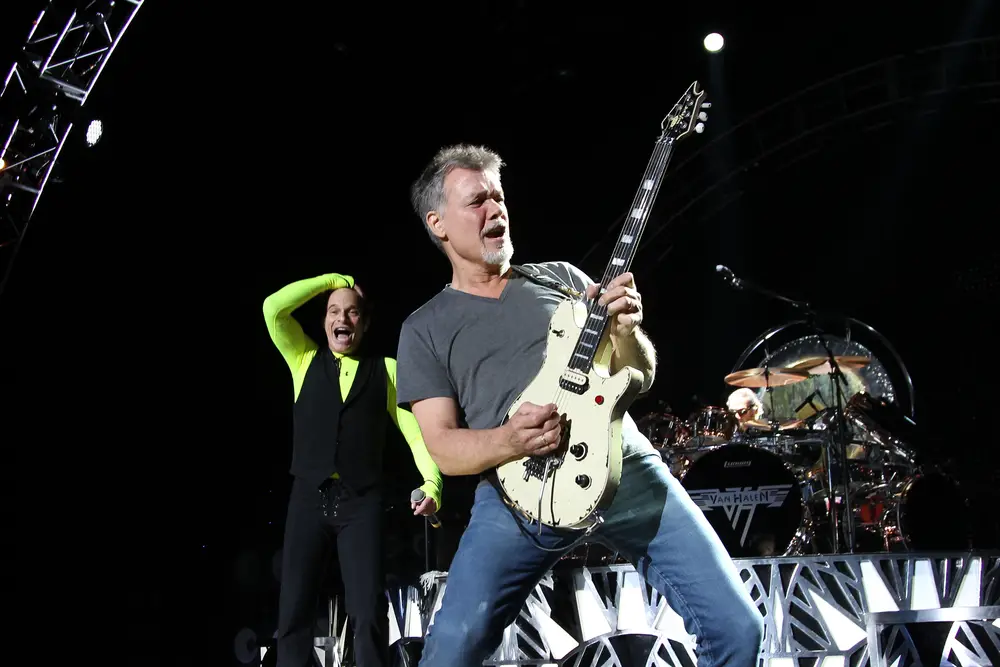
Which pickup did Eddie use in the Frankenstrat?
What is the best pickup for emulating Van Halen’s sound?
Which pickup did EVH use in his 5150 guitar?
Eddie Van Halen used a single humbucker pickup in his 5150 guitar. However, the exact model of the pickup is not well-documented. It is very likely that he used a custom-wound pickup, possibly made by Seymour Duncan, designed to meet his tonal preferences.
Why did Eddie Van Halen prefer using just one pickup?
Eddie Van Halen’s minimalistic approach to guitar setups allowed him to focus on his playing technique and tone without being distracted by overly complicated gear.
By using only one pickup, he could dial in his desired sound and avoid interference from the unused pickup, which could potentially impact the guitar’s sustain and overall tone.
Did Eddie Van Halen use a DiMarzio Super Distortion?
While there is no definitive evidence that Eddie Van Halen used a DiMarzio Super Distortion, he experimented with various pickups throughout his career.
The DiMarzio Super Distortion’s high output and midrange-focused tone make it a possible candidate for creating a Van Halen-esque sound, but it is not certain if Eddie used this particular pickup.
What are the differences between EVH Frankenstein and DiMarzio Tone Zone pickups?
The EVH Frankenstein pickup, designed by Eddie Van Halen in collaboration with Fender, aims to replicate the iconic sound of his Frankenstrat guitar. The DiMarzio Tone Zone, on the other hand, is a different pickup designed to provide a powerful and dynamic tonal range.
While both pickups can create a sound reminiscent of Eddie’s legendary tone, the EVH Frankenstein is more specifically designed to emulate that sound. The DiMarzio Tone Zone offers a broader range of tonal options, extending beyond the signature Van Halen sound.

My name is Howard Matthews and I have been playing the guitar since I was knee-high. My parents like to joke that I was pulling the strings even before I was born. In fact, one of my earliest memories is sitting on the couch with my dad’s guitar, wreaking havoc on the chords.
Now, 40 years later, I can attest that I play them much better than I did back then. I have followed in the footsteps of both my parents – much to their delight – and have been the main guitarist in my band for the best part of three decades.
Music has always been my passion, and until recently my life has been so consumed with it that I haven’t had a moment to have a breath (and I wouldn’t have it any other way)!

